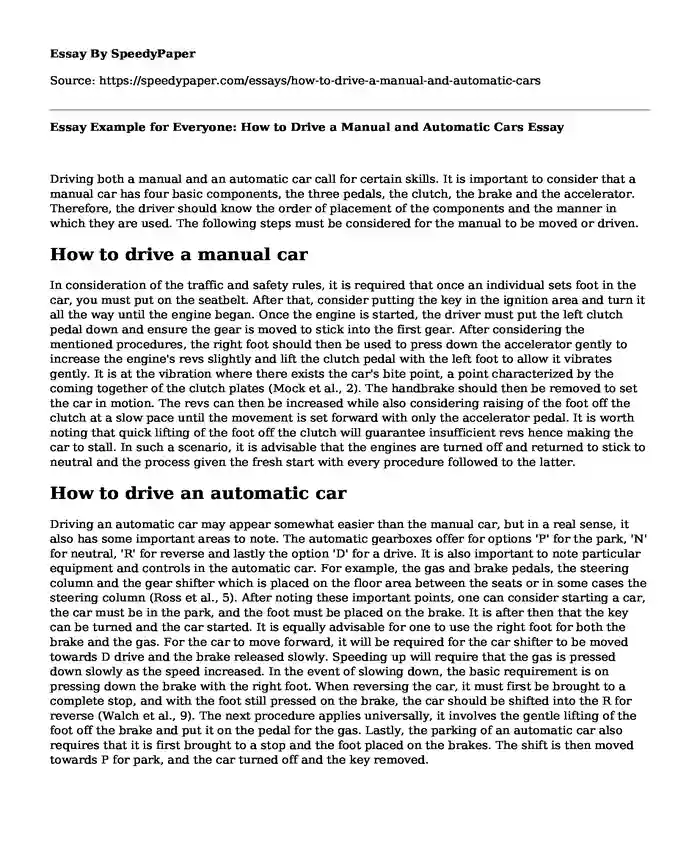
| Type of paper: | Essay |
| Categories: | Technology Other |
| Pages: | 3 |
| Wordcount: | 708 words |
Driving both a manual and an automatic car call for certain skills. It is important to consider that a manual car has four basic components, the three pedals, the clutch, the brake and the accelerator. Therefore, the driver should know the order of placement of the components and the manner in which they are used. The following steps must be considered for the manual to be moved or driven.
How to drive a manual car
In consideration of the traffic and safety rules, it is required that once an individual sets foot in the car, you must put on the seatbelt. After that, consider putting the key in the ignition area and turn it all the way until the engine began. Once the engine is started, the driver must put the left clutch pedal down and ensure the gear is moved to stick into the first gear. After considering the mentioned procedures, the right foot should then be used to press down the accelerator gently to increase the engine's revs slightly and lift the clutch pedal with the left foot to allow it vibrates gently. It is at the vibration where there exists the car's bite point, a point characterized by the coming together of the clutch plates (Mock et al., 2). The handbrake should then be removed to set the car in motion. The revs can then be increased while also considering raising of the foot off the clutch at a slow pace until the movement is set forward with only the accelerator pedal. It is worth noting that quick lifting of the foot off the clutch will guarantee insufficient revs hence making the car to stall. In such a scenario, it is advisable that the engines are turned off and returned to stick to neutral and the process given the fresh start with every procedure followed to the latter.
How to drive an automatic car
Driving an automatic car may appear somewhat easier than the manual car, but in a real sense, it also has some important areas to note. The automatic gearboxes offer for options 'P' for the park, 'N' for neutral, 'R' for reverse and lastly the option 'D' for a drive. It is also important to note particular equipment and controls in the automatic car. For example, the gas and brake pedals, the steering column and the gear shifter which is placed on the floor area between the seats or in some cases the steering column (Ross et al., 5). After noting these important points, one can consider starting a car, the car must be in the park, and the foot must be placed on the brake. It is after then that the key can be turned and the car started. It is equally advisable for one to use the right foot for both the brake and the gas. For the car to move forward, it will be required for the car shifter to be moved towards D drive and the brake released slowly. Speeding up will require that the gas is pressed down slowly as the speed increased. In the event of slowing down, the basic requirement is on pressing down the brake with the right foot. When reversing the car, it must first be brought to a complete stop, and with the foot still pressed on the brake, the car should be shifted into the R for reverse (Walch et al., 9). The next procedure applies universally, it involves the gentle lifting of the foot off the brake and put it on the pedal for the gas. Lastly, the parking of an automatic car also requires that it is first brought to a stop and the foot placed on the brakes. The shift is then moved towards P for park, and the car turned off and the key removed.
Works Cited
Mock, Peter, et al. "The WLTP: How a new test procedure for cars will affect fuel consumption values in the EU." International Council on Clean Transportation 9 (2014): 35-47.
Ross, Pamela E., et al. "Interventions for resuming driving after traumatic brain injury." Disability and Rehabilitation 40.7 (2018): 757-764.
Walch, Marcel, et al. "Autonomous driving: investigating the feasibility of car-driver handover assistance." Proceedings of the 7th international conference on automotive user interfaces and interactive vehicular applications. ACM, 2015.
Cite this page
Essay Example for Everyone: How to Drive a Manual and Automatic Cars. (2022, Mar 30). Retrieved from https://speedypaper.com/essays/how-to-drive-a-manual-and-automatic-cars
Request Removal
If you are the original author of this essay and no longer wish to have it published on the SpeedyPaper website, please click below to request its removal:
- Bank Teller Cover Letter - Free Essay Sample for You
- Free Essay on Destroying Rainforest: Message to Indonesia President
- Essay Sample: Byzantine Ambassadors as Related by Ibn Al-Khatib
- Total S.A. vs. Royal Dutch Shell - Financial Analysis Essay Sample
- Essay Sample Answering How Voter Turnout Could Be Increased in Texas
- Essay Sample on Central Practices for Passing on Christian Faith
- Essay Sample on Immigrant and Undocumented Youth in Higher Education
Popular categories




